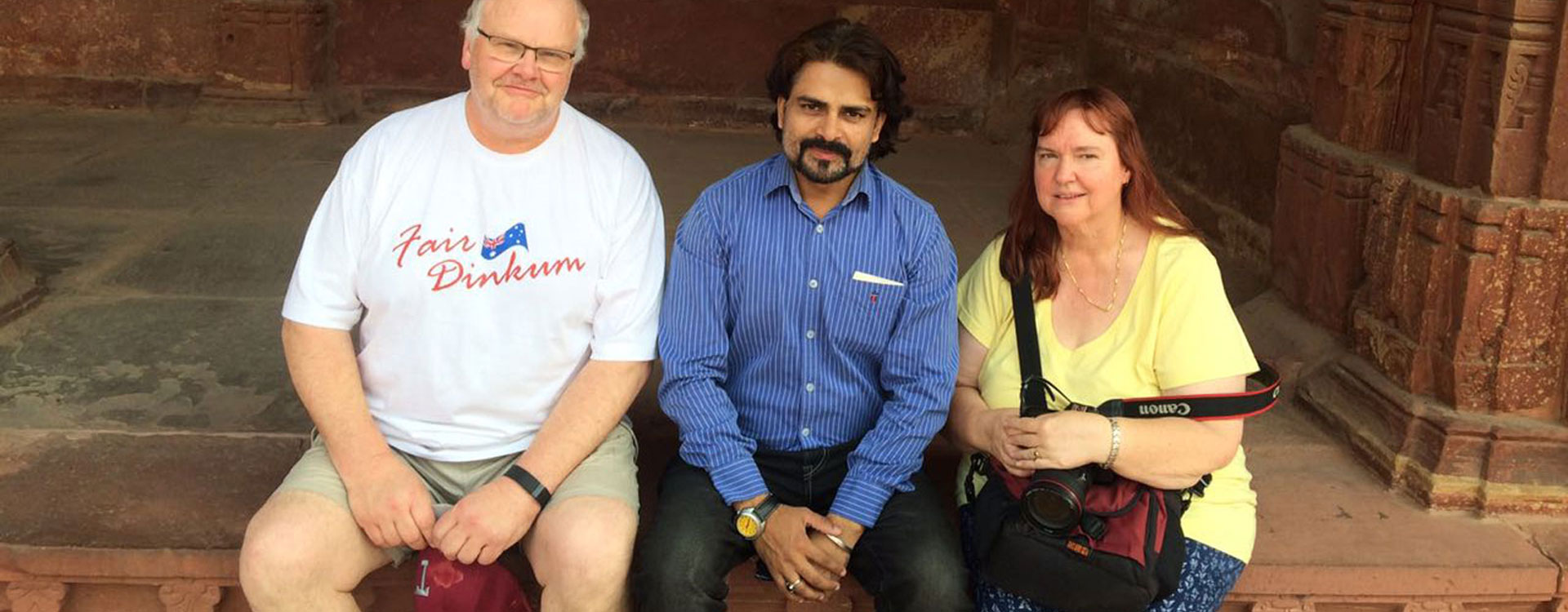
Uttar Pradesh
Uttar Pradesh is the microcosm of India, multicultural, multiracial, conglomeration of fabulous wealth of nature-hills, valleys, rivers, forests, and vast plains. Viewed as the largest tourist destination in India, Uttar Pradesh boasts of 35 million domestic tourists. Its tourism promotion budget is bigger than that of government of India and half of the states of the Indian union combined. Uttar Pradesh is studded with places of tourist attractions across a wide spectrum of interest to people of diverse interests.The seventh most populated state of the world, Uttar Pradesh can lay claim to be the oldest seat of India's culture and civilization. It has been characterized as the cradle of Indian civilization and culture because it is around the Ganga that the ancient cities and towns sprang up.
Uttar Pradesh has an enormous historical legacy. The renowned epics of Hinduism-the Ramayana and the Mahabharata-were written in Uttar Pradesh. Uttar Pradesh also had the glory of being home to Lord Buddha. It has now been established that Gautama Buddha spent most of his life in eastern Uttar Pradesh, wandering from place to place preaching his sermons.The empire of Chandra Gupta Maurya extended nearly over the whole of Uttar Pradesh. Edicts of this period have been found at Allahabad, Varanasi, and Dehradun. After the fall of the Mauryas, the present state of Uttar Pradesh was divided into four parts: Surseva, North Panchal, Kosal, and Kaushambi. The western part of Uttar Pradesh saw the advent of the Shaks in the second century BC. Not much is known of the history of the state during the times of Kanishka and his successors.The Gupta Empire ruled over nearly the whole of Uttar Pradesh, and it was during this time that culture and architecture reached its peak. The decline of the Guptas coincided with the attacks of Huns from Central Asia who succeeded establishing their influence right up to Gwalior in Madhya Pradesh. The seventh century witnessed the taking over of Kannauj by Harshavardhan.In 1526, Babur laid the foundation of the Mughal dynasty. He defeated Ibrahim Lodi in the battle of Panipat.
Babar carried out extensive campaign in various parts of Uttar Pradesh. He defeated the Rajputs near Fatehpur Sikri while his son Humayun conquered Jaunpur and Ghazipur, after having brought the whole of Awadh under his control. After Babur's death (1530), his son Humayun forfeited the empire after being defeated at the hands of Sher Shah Suri at Kannauj. After the death of Sher Shah Suri in 1545, Humayun once again regained his empire but died soon after.His son Akbar proved to be the greatest of Mughals. His established a unified empire over nearly the whole of the India. During his period, Agra became the capital of India and became heartland of culture and arts. Akbar laid the foundation of modern Indian administration in many respects. His reign saw peace, tranquility, and progress. He constructed huge forts in Agra and Allahabad. He shifted his capital to a city called Fatehpur Sikri close to Agra that for some years became the hub of administration.In 1605, Akbar died and was succeeded by his son Jahangir. The period of Jahangir saw arts and culture reach a new high. However, politically and administratively, the real power during this time rested with the queen Nurjahan.In 1627, after the death of Jahangir, his son Shahjahan ascended the throne. The period of Shahjahan is known as the golden period of India in art, culture, and architecture. It was during his reign that the classical wonder Taj Mahal was built in memory of his wife Mumtaz Mahal. He also constructed the famous Red Fort in Delhi as well as the Jama Masjid and Moti Mahal.During his later life, Shahjahan was deposed by his son Aurangzeb. Aurangzeb shifted his capital to Delhi, where he kept his father Shahjahan imprisoned until his death. The régime of Aurangzeb saw innumerable revolts and riots; the whole of Rajputana and the Deccan became restive. However, it was during his reign that the Mughal Empire reached its peak in terms of geographic expansion. But with the death of Aurangzeb in 1707, the Mughal Empire declined at an amazing pace.Modern-day Uttar Pradesh saw the rise of important freedom fighters on the national scenario. Lal Bahadur Shastri, Jawaharlal Nehru, Smt. Indira Gandhi, and Charan Singh were only a few of the important names who played a significant role in India's freedom movement and also rose to become the prime ministers of this great nation.
Located in the Northern Plains of India, Uttar Pradesh is easily accessible throughout the year. However, the best time to visit Uttar Pradesh is during the winter season. Due to its geographic location, the state experiences extreme temperature during the summer season and descent waterfall, making winter one of the most predictable season. The pleasant temperature assists day excursion tour, making winter months the best time to visit the state.
A developing state, Uttar Pradesh is expanding on its already existing infrastructure. Well-connected by road, rail and air, and thus, reaching any tourist destination is fairly easy. However, rail and road remain the best way to reach Uttar Pradesh. Most part of the state is easily accessible through state and national highways along with good rail connectivity. The air connectivity is also decent in the state with a total of 2 International airports and at least 4 more functional domestic airports and many more proposed for the near future.
The international airports in Uttar Pradesh are Chaudhary Charan Singh Aiport in Lucknow and Lal Bahadur Shashtri Aiport in Varanasi. Apart from them, there are domestic airports in Gorakhpur, Agra, Jhansi, Meerut, Prayagraj (Allahabad), and Kanpur.
One of the best ways to reach Uttar Pradesh is by railways. With a total of more than 430 functional railway stations in the state, reaching tourist destinations in the state via train is easy. Some of the biggest railway stations in the state are Lucknow, Prayagraj (Allahabad), Kanpur, Varanasi, Meerut, Jhansi, Agra, and Mathura.
One of the easiest ways to reach Uttar Pradesh is via roads. There are several National Highways and expressways in the state like Yamuna Express Way, Agra Expressway, NH 19, NH 34, NH 30 and NH 21. The state highways are also well-maintained and Uttar Pradesh State Road Transport Corporation operates buses on all major routes in the state.
Literally speaking, Uttar Pradesh is shoppers delight. No where and I repeat, no where in India will you get a range of products on offering as in Uttar Pradesh. It will not be a bit of aberration to say that almost each and every town of Uttar Pradesh has something or other for you to offer. The reason behind this phenomenon is the rich art and crafts heritage of this state. Muslims, who are considered to be master craftsman in India, are present in a sizable number in most of the cities of Uttar Pradesh. Most of these families are traditional craftsmen who have been patronized by some or other royals in the course of History.Starting from western Uttar Pradesh, Moradabad should be your first destination. The place is famous throughout the world for its brassware and bronzes. You can shop for beautiful bronze and copper items that include small busts and statues, utensils, mementoes and memorabilia. These are a must buy items. Nearby is Aligarh, a town famous for its locks. The locks that are manufactured here are exported throughout the world. Even the famous 'Chinese Locks' are produced in Aligarh only. Close by are Saharanpur and Bareilly; towns that are famous for furniture. While the former has an expertise in wooden furniture the later excels in Wrought Iron goods. The shops have facility to deliver the desired goods anywhere in India and World. Check out some of them.In between falls Rampur, a city that has almost legendry stature in manufacturing knives. The city produces knives of every kind and make. You are not allowed to carry these on Airplanes therefore you will have to be contained with the miniatures. Firozabad is famous for glassware. The glass items especially bangles are famous all over the world. Apart from bangles there are many kinds of dinner-sets and other cutleries. The Taj city of Agra is not far behind. The city offers some of the masterpieces of marble and bone works. The must buys are miniature marble Taj and Elephant Bone statues of Jesus Christ. Farrukhabad and Pilakhua are famous for hand-printing works. These cities produce some of the most beautiful bed sheets and drapes in the world. Do buy a few of them for they are very costly in Europe.In the central Uttar Pradesh and Oudh region, Lucknow rules the roost. The town is the only center in the world for the famous Chikankari works on the clothes. These clothes are extremely fine and compete with the muslins of Murshidabad. This is a must buy in UP. The craze of this item among British is legend in itself. Kanpur, a city just 80 kilometers from Lucknow, is famous for its leather products. The city produces leather items of the finest quality. Do buy a few wallets and belts.
The Taj was built by Shah Jahan as a memorial for his third wife, Mumtaz Mahal, who died giving birth to their 14th child in 1631. The death of Mumtaz left the emperor so heartbroken that his hair is said to have turned grey virtually overnight. Construction of the Taj began the following year; although the main building is thought to have been built in eight years, the whole complex was not completed until 1653. Not long after it was finished, Shah Jahan was overthrown by his son Aurangzeb and imprisoned in Agra Fort, where for the rest of his days he could only gaze out at his creation through a window. Following his death in 1666, Shah Jahan was buried here alongside his beloved Mumtaz.In total, some 20,000 people from India and Central Asia worked on the building. Specialists were brought in from as far away as Europe to produce the exquisite marble screens and pietra dura (marble inlay work) made with thousands of semiprecious stones.The Taj was designated a World Heritage Site in 1983 and looks nearly as immaculate today as when it was first constructed – though it underwent a huge restoration project in the early 20th century.• Entry & InformationNote: the Taj is closed every Friday to anyone not attending prayers at the mosque.The Taj can be accessed through the west and east gates. The south gate was closed to visitors in 2018 for security concerns but can be used to exit the Taj. The east gate generally has shorter queues. There are separate queues for men and women at both gates. If you are a foreigner, once you get your ticket, you can skip ahead of the lines of Indians waiting to get in – one perk of your pricey entry fee. It's possible to buy your tickets online in advance at https://asi.payumoney.com (you'll get a ₹50 discount for your troubles), but you won't save much time as you still have to join the main security queue. A ticket that includes entrance to the mausoleum itself cost ₹200 extra.Cameras and videos are permitted, but you can't take photographs inside the mausoleum itself. Tripods are banned.Remember to retrieve your free 500ml bottle of water and shoe covers (included in Taj ticket price). If you keep your ticket, you get small entry-fee discounts when visiting Agra Fort, Fatehpur Sikri, Akbar's Tomb or the Itimad-ud-Daulah on the same day. Bags much bigger than a money pouch are not allowed inside; free bag storage is available. Any food or tobacco will be confiscated when you go through security, as will pens.





